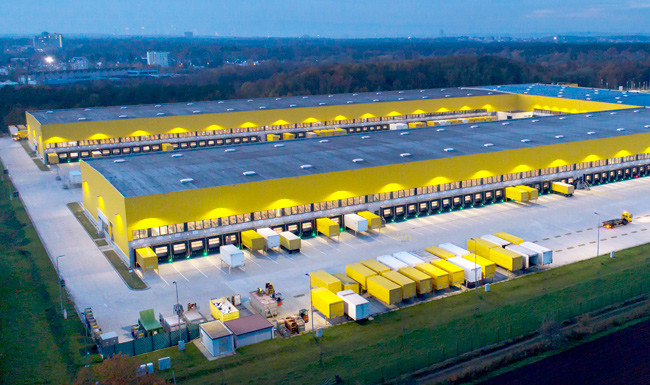
How Vendor Managed Inventory (VMI) Strengthens Supply Chain Resilience and Collaboration
To optimize inventory management, retailers and suppliers are increasingly turning to Vendor Managed Inventory (VMI) tools that transfer the responsibility…
Generix Ushers in a New Era of Intelligent Commerce for Retailers with AI-Driven Innovation Read the press release

The rise in e-commerce in the past five to seven years has placed added pressures on warehouses and logistics companies to meet ever-shortening delivery times. Warehouse operators have responded by building more warehouses closer to urban areas to reduce delivery times. They have ramped up their technology platforms to streamline warehouse storage, maximize space, and better organize SKUs for faster picking.
When the global pandemic struck, e-commerce hit sales numbers that were years ahead of projections, going from an already sizeable 600 billion USD in 2019 to something approaching 6.5 TRILLION by 2023.
The Covid-19 virus rammed through rapid and enormous changes in consumer patterns, literally overnight. It caught warehouse operators and logistics companies by surprise but, at least warehouse operations were extensively digitalized and more able to handle the sudden spike in operational requirements.
The effect on transportation operators was harsh, especially for fast-moving consumer goods (FMCG): drivers were working longer, logging more and more hours, and, in the early stages of the pandemic, facing restrictions around public rest stops and diners along their routes. This only exacerbated the issue of a chronic shortage of drivers.
For supply chains to become even leaner and faster in the future, meeting the demands of today’s customer, logistics firms will have to step up their game. To that end, here are several examples of how this will happen in the near future – or is already happening now.
Truck platooning technology is already well underway. Scania in Sweden and Peloton in the U.S. have both been conducting trials. Truck platooning involves two or more trucks linked electronically in such a way that the lead truck sets the pace and the following trucks automatically adjust speed, braking, distance, and turning to match the lead vehicle. While each truck contains a human behind the wheel, that driver is there to monitor and react manually to an emergency. However, as technology gets better, a platoon of trucks may ultimately contain only a single driver in the lead truck. The benefits of platooning are said to include more efficient use of space on highways and fuel reduction rates of up to 20%.
In a way, this is logistics without the fleet. Uber pioneered the concept of using a mobile device to hail a ride and then moved into the freight business with Uber Freight; using the Uber Freight technology platform, shippers can input load details into the system. Truck drivers or dispatchers provide market prices and agree to the terms, and within minutes, both sides can make a match.
Amazon is taking this concept to the next level with Amazon Flex. Contract drivers sign up on the Flex app for a three-to-six hour block of deliveries for which the company pays them between USD 18 and 25 per hour. It’s part of Amazon’s attempt to make one-day shipping the norm for its Amazon Prime customers.
Blockchain technology first came into the popular lexicon as the “security” behind cryptocurrency but was quickly left behind as cryptocurrencies began to dominate the public’s imagination. Blockchain technology has widespread applications, finding uses in any activities, professions, or transactions demanding some level of security and privacy.
For the logistics industry, blockchain can be transforming, especially where lengthy supply chains are involved. Container shipping – whether export or import – passes through numerous hands before the containerized goods reach their final destination. Blockchain technology acts like a ledger, visible to all who have access to it, and records every detail of a container’s journey to the final destination. Those details cannot be tampered with and, as a result, form a barrier of protection and create a level of trust among all parties involved.
The technology is already in use within the logistics industry through the Blockchain in Transport Alliance (BITA), formed in 2017. Member firms like UPS and BNSF Railway are involved. In fact, since its inception, BITA has become the largest commercial blockchain alliance in the world with more than 500 member companies, all of whom operate in the logistics and transport space.
The muscle behind truck platooning, asset-free logistics companies, and blockchain technology is data. Data is the life-blood of literally all technology applications today. Turning data into power is what specialized technology companies like Generix Group North America do. Not only does Generix provide software platform-based solutions across the entire supply chain, we understand the challenges that companies face today and we provide the expertise to create efficiencies throughout the value chain, as well.
Our clients span the globe and our view is global, too. We invite you to contact us and find out how our experience and solutions can assist your organization.

To optimize inventory management, retailers and suppliers are increasingly turning to Vendor Managed Inventory (VMI) tools that transfer the responsibility…

In an ever-evolving logistics environment, agile and precise warehouse resource management is essential to remain competitive. With increasing volumes driven…

France’s electronic invoicing reform relies on a Y-architecture, where Partner Dematerialization Providers (PDPs) play a central role in issuing and…

Work with our team to build your ideal supply chain software stack and tailor it to your unique business needs.